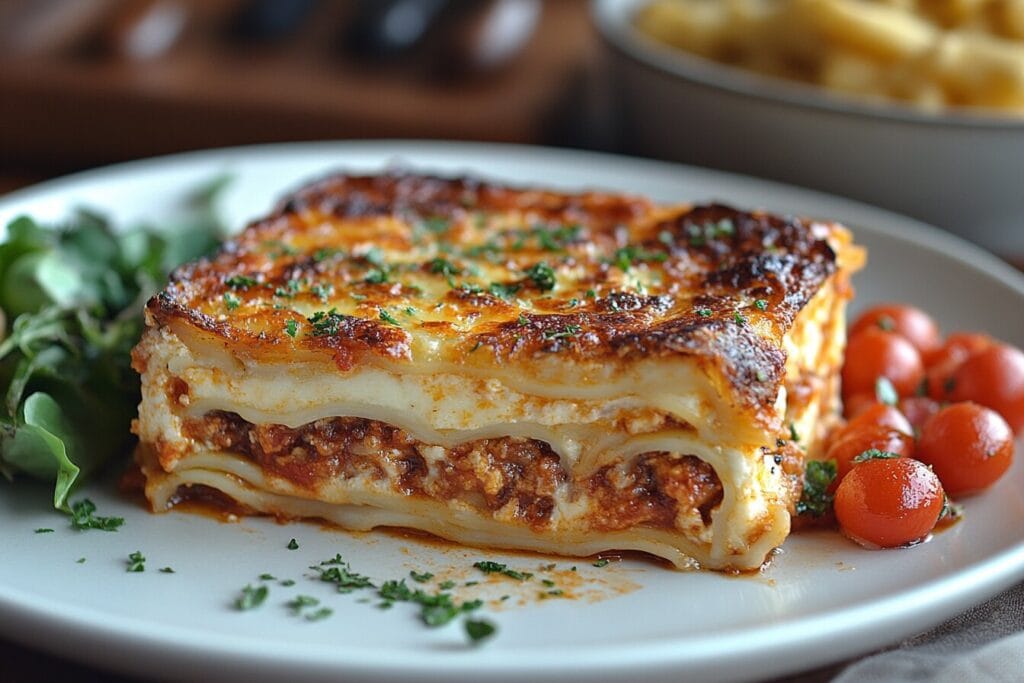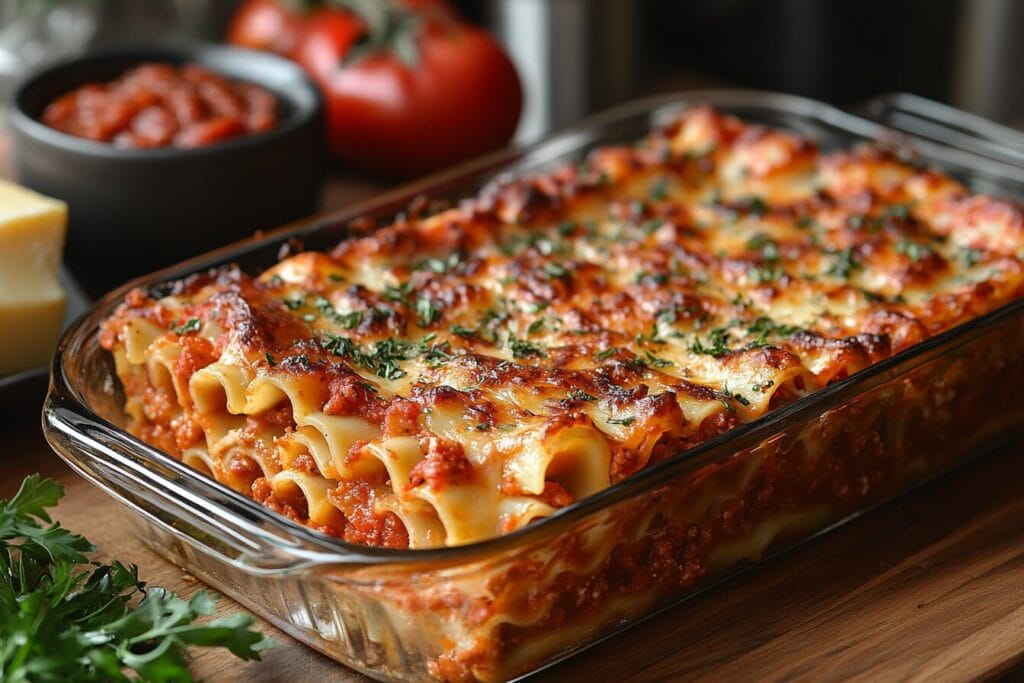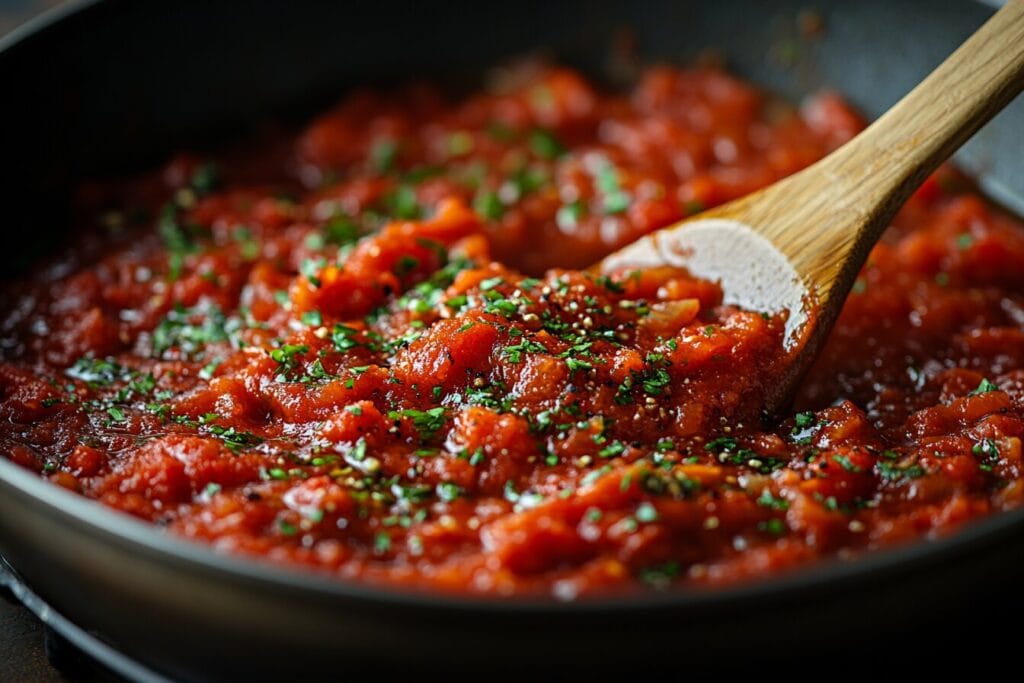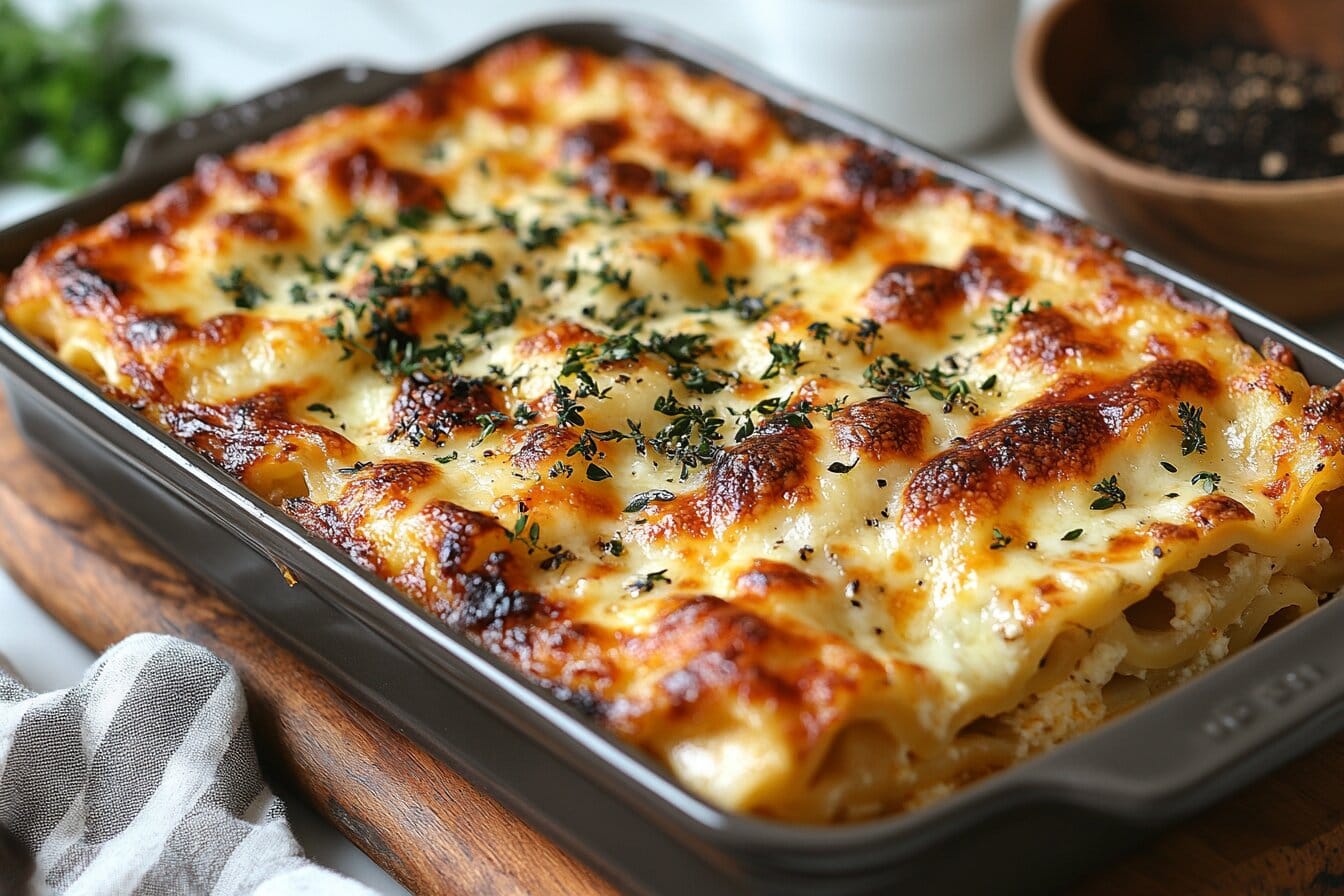Introduction
Lasagna is a beloved comfort food, but when the noodles turn gummy, it can ruin the entire dish. Understanding why your lasagna noodles are gummy is essential to achieving the perfect texture. Whether it’s due to overcooking, improper layering, or sauce consistency, this guide will help you fix and prevent gummy lasagna noodles.
Understanding why your lasagna noodles become gummy is the first step to perfecting your dish. Whether it’s an issue with your cooking method, choice of noodles, or assembly technique, a variety of factors can contribute to this common problem. By identifying these culprits and learning the right techniques, you can ensure your lasagna is flawless every time.
In this article, we’ll delve into the reasons behind gummy lasagna noodles, explore how different cooking methods impact their texture, and provide actionable tips to avoid this kitchen mishap.

Causes of Gummy Lasagna Noodles
When lasagna noodles turn gummy, the issue often stems from missteps in preparation or assembly. To achieve that perfect al dente texture, understanding the causes is crucial. Let’s examine some of the most common reasons why lasagna noodles become gummy.
Overcooking the Noodles
Overcooking is one of the primary culprits behind gummy lasagna noodles. When boiled for too long, the starches in the noodles break down excessively, leading to a sticky, soft consistency. This problem is exacerbated during baking, where noodles are exposed to more moisture and heat, further compromising their structure.
- Signs of Overcooking: Noodles that are overly limp or begin to tear easily in water.
- How It Happens: Lack of attention during boiling or following inaccurate cooking times on packaging.
- Solution: Boil noodles 1-2 minutes less than the package directions if they will continue cooking in the oven.
Improper Layering Techniques
The layering process can make or break your lasagna. Gummy noodles often result from excess moisture in the dish or uneven distribution of ingredients.
- Too Much Sauce: Excess sauce saturates the noodles, turning them mushy during baking.
- Incorrect Cheese Application: Applying cheese directly onto noodles without a sauce layer can trap moisture, softening the noodles.
- Solution: Use a balanced amount of sauce, ensuring that noodles are coated evenly but not drowning.
Sauce Consistency
The sauce used in lasagna plays a pivotal role in noodle texture. A watery sauce can seep into the noodles during baking, making them sticky and overly soft.
- Common Errors:
- Using unstrained canned tomatoes.
- Adding too much water to homemade sauces.
- Solution: Ensure your sauce is thick enough to coat a spoon but not runny. Simmer homemade sauces longer to evaporate excess liquid.
Choice of Noodles
Not all lasagna noodles are created equal. Low-quality noodles or those unsuitable for your chosen method of preparation can lead to gummy results.
- Traditional Boil vs. No-Boil:
- Traditional noodles require precise cooking times.
- No-boil noodles need sufficient moisture from the sauce to soften properly.
- Solution: Choose noodles suited to your recipe. If using no-boil noodles, ensure your sauce has enough liquid to hydrate them during baking.
By addressing these common causes, you can pinpoint where things might be going wrong in your lasagna-making process. Next, let’s explore how different cooking methods impact noodle texture and what you can do to perfect your lasagna.
How Cooking Methods Impact Texture
The method you use to cook lasagna noodles significantly influences their final texture. From boiling to baking, each step requires attention to detail to avoid gummy noodles. Let’s break down how different cooking methods impact noodle texture and how you can optimize each approach.
Boiling Noodles – The Right Way
Traditional lasagna recipes often call for boiling noodles before assembling the dish. While this method provides control over noodle texture, it’s also where many cooks go wrong.
- Common Mistakes in Boiling:
- Overcrowding the Pot: When too many noodles are boiled at once, they stick together, leading to uneven cooking and clumps.
- Skipping the Stirring: Without stirring, noodles may stick to the pot or each other, causing tears or gummy patches.
- Ignoring Cooking Times: Overcooking noodles in boiling water leaves them vulnerable to further softening during baking.
- Proper Technique:
- Use a large pot with plenty of water to prevent noodles from sticking.
- Add salt to the water to enhance flavor and reduce stickiness.
- Stir gently but frequently during cooking.
- Cook noodles slightly underdone (al dente) since they will continue cooking in the oven.
Skipping the Boil – No-Boil Noodles
No-boil lasagna noodles are a convenient alternative, but they require precise assembly to avoid gummy results. These noodles rely on moisture from the sauce to hydrate during baking.
- Challenges with No-Boil Noodles:
- Inadequate Sauce: A dry or thick sauce won’t provide enough liquid for the noodles to soften properly.
- Overhydration: Adding too much liquid can lead to mushy layers.
- Tips for Success:
- Use a sauce with a balanced consistency—not too thick or watery.
- Ensure the sauce completely covers the noodles in each layer to prevent dry or uneven cooking.
- Bake covered for the first half of the cooking time to lock in moisture, then uncover to allow excess moisture to evaporate.
Baking and Assembly Techniques
The baking process is where everything comes together—or falls apart. Gummy noodles are often the result of poor heat distribution or improper layering during assembly.
- Temperature and Time:
- Baking at too high a temperature can cause uneven cooking, softening some noodles while drying others.
- Overbaking leads to excess moisture absorption, making noodles sticky.
- Layering Issues:
- Uneven layers or inconsistent sauce distribution can result in gummy or undercooked patches.
- Optimal Baking Practices:
- Bake at 375°F (190°C) for 30-40 minutes, depending on the recipe.
- Cover with foil for the first 20-25 minutes to retain moisture, then uncover to achieve a golden-brown top layer.
- Let the lasagna rest for 10-15 minutes after baking. This allows the noodles to set and prevents a soggy texture when serving.
Alternate Cooking Methods
In addition to traditional baking, some cooks use alternative methods like pressure cookers or stovetop lasagna. Each comes with unique challenges for noodle texture.
- Pressure Cooker:
- Quick cooking times can lead to uneven noodle hydration.
- Use no-boil noodles and adequate sauce to prevent stickiness.
- Stovetop Lasagna:
- Requires careful layering to avoid noodles sticking to the pan.
- Use a non-stick surface and consistent heat for best results.
By tailoring your cooking method to your chosen noodles and recipe, you can achieve perfect texture every time. In the next section, we’ll explore preparation techniques to further enhance your lasagna-making skills.
Proper Preparation Techniques
Perfecting your lasagna noodles starts with proper preparation. Whether you’re boiling traditional noodles, using no-boil varieties, or assembling a lasagna for baking, the steps you take before cooking play a crucial role in the final texture. Let’s explore how to prepare lasagna noodles to avoid the dreaded gummy texture.

Boiling Noodles Correctly
When using traditional lasagna noodles, boiling them to the right consistency is essential. Follow these steps to ensure your noodles are ready for layering without becoming sticky or overcooked:
- Choose the Right Pot and Water Ratio:
- Use a large pot filled with at least 4-6 quarts of water to give noodles space to cook evenly.
- Add a generous pinch of salt to enhance the noodles’ flavor.
- Monitor the Cooking Time:
- Check the package instructions for the recommended cooking time.
- Cook noodles 1-2 minutes less than instructed to achieve a firm, al dente texture.
- Prevent Sticking:
- Stir noodles gently but frequently to prevent them from clumping together.
- Avoid adding oil to the boiling water, as it can prevent sauce from adhering to the noodles later.
- Cooling and Drying:
- After draining, rinse the noodles briefly with cold water to halt cooking.
- Lay them flat on a clean towel or parchment paper to dry, preventing them from sticking to each other.
Preparing No-Boil Noodles
No-boil noodles save time but require careful handling to achieve the perfect texture. Here’s how to use them effectively:
- Choose the Right Sauce Consistency:
- Ensure your sauce has enough liquid to hydrate the noodles during baking.
- For each layer, aim for a sauce-to-noodle ratio that fully coats the noodles without oversaturating them.
- Layer Strategically:
- Begin with a thin layer of sauce at the bottom of the baking dish to prevent noodles from sticking.
- Alternate noodles, sauce, cheese, and other ingredients, ensuring the noodles are always surrounded by moisture.
- Cover During Baking:
- Cover the dish with aluminum foil for the first 20-30 minutes of baking to retain moisture and ensure even cooking.
- Remove the foil toward the end to allow the top layer to crisp up.
Using Fresh Lasagna Sheets
If you prefer fresh lasagna sheets over dried noodles, preparation is slightly different. Fresh pasta tends to be more delicate, requiring minimal pre-cooking:
- Blanching Instead of Boiling:
- Fresh sheets only need a quick blanch (1-2 minutes) in boiling water.
- After blanching, cool the sheets in an ice bath and pat them dry before layering.
- Handling Fresh Dough:
- Fresh sheets should be thin and pliable but sturdy enough to hold the layers.
- Dust the sheets lightly with flour to prevent sticking during assembly.
Assembling Lasagna for Even Cooking
Proper assembly ensures that every layer cooks evenly, preventing gummy noodles or dry spots:
- Layer Consistently:
- Use uniform layers of noodles, sauce, and cheese for balanced cooking.
- Avoid overloading any single layer with too much sauce or cheese.
- Start and End with Sauce:
- Begin with a layer of sauce to prevent sticking and promote even hydration.
- Finish with a generous sauce and cheese layer to protect the top noodles from drying out.
- Distribute Ingredients Evenly:
- Spread ingredients all the way to the edges of the pan to avoid undercooked corners.
Resting Before Serving
One often-overlooked step is allowing the lasagna to rest after baking. Resting helps the layers set, reducing excess moisture and ensuring a clean slice.
- Why It’s Important:
- Slicing immediately after baking can cause layers to slide apart, and noodles may seem gummy due to trapped steam.
- How to Rest Properly:
- Let the lasagna cool for at least 10-15 minutes before cutting.
- Use a sharp knife to cut clean slices without disrupting the layers.
With proper preparation, your lasagna noodles can maintain their ideal texture and complement the rich flavors of the dish. In the next section, we’ll discuss how choosing the right ingredients further enhances your lasagna.
Choosing the Right Ingredients
The ingredients you use in your lasagna can dramatically impact the texture and flavor of the final dish. From the type of noodles to the quality of sauce and cheese, each component plays a critical role in avoiding gummy lasagna noodles and creating a harmonious, well-balanced meal.

Selecting High-Quality Noodle
The foundation of any lasagna is its noodles, and choosing the right type is essential for achieving the perfect texture.
- Traditional Dried Noodles:
- Look for brands that use durum wheat semolina for a firmer texture.
- Avoid low-cost noodles that may break apart during boiling or baking.
- No-Boil Noodles:
- Opt for reputable brands designed to hydrate properly during baking.
- Check reviews or recommendations to ensure consistent results with no-boil noodles.
- Fresh Pasta Sheets:
- Fresh pasta provides a delicate, melt-in-your-mouth texture.
- Use homemade or artisanal fresh sheets for a premium experience.
Choosing the Perfect Sauce
The sauce is the glue that holds lasagna together, and its consistency is critical for noodle texture.
- Homemade vs. Store-Bought:
- Homemade sauces allow you to control thickness and flavor.
- When using store-bought sauces, choose high-quality brands with a rich texture and minimal added sugars.
- Consistency Matters:
- A good lasagna sauce should be thick enough to coat a spoon but not so dense that it lacks moisture.
- If the sauce is too watery, reduce it by simmering to concentrate the flavors.
- Balancing Ingredients:
- Tomato-based sauces are classic, but cream-based options like béchamel can add a luxurious twist.
- Avoid sauces with excessive oil, which can cause uneven cooking and separation during baking.
Using the Right Cheese
Cheese is another key player in lasagna, contributing both to texture and flavor. The type and quality of cheese can make a significant difference.
- Types of Cheese:
- Mozzarella: Use low-moisture mozzarella for stretchiness without excess water.
- Ricotta: Choose creamy ricotta to avoid a grainy texture; drain if it’s too watery.
- Parmesan: Adds depth and umami. Grate fresh Parmesan for the best results.
- Other Options: Experiment with provolone, fontina, or mascarpone for unique flavor profiles.
- Cheese Distribution:
- Spread cheese evenly in each layer to avoid pooling or clumps.
- Use a mix of cheeses for complexity and balance.
Enhancing Flavor with Herbs and Spices
Seasoning plays a subtle but important role in perfecting your lasagna:
- Fresh Herbs:
- Basil, parsley, and oregano enhance the flavor of the sauce and add freshness to each layer.
- Add herbs sparingly to avoid overpowering other ingredients.
- Spices:
- Incorporate garlic powder, black pepper, and a pinch of nutmeg (especially in cream-based sauces) for a warm, balanced flavor.
- Avoid overusing salt, as the cheese and sauce may already provide enough.
Choosing the Right Pan
The baking dish you use also affects noodle texture.
- Material:
- Glass or ceramic dishes distribute heat evenly, preventing overcooking or gummy layers.
- Avoid metal pans, which can react with acidic sauces and affect flavor.
- Size:
- Choose a dish that fits your noodle size to minimize overlap or uneven cooking.
- Avoid overfilling the pan, as this can lead to soggy layers.
Using High-Quality Layers
Each layer in your lasagna should complement the others for a balanced dish:
- Meat and Vegetables:
- Cook and drain ground meats thoroughly to remove excess grease.
- Use pre-cooked or sautéed vegetables to avoid releasing too much water during baking.
- Layer Balance:
- Avoid using too much of any single ingredient, which can overwhelm the dish or affect texture.
- Maintain a consistent ratio of noodles, sauce, cheese, and other ingredients.
By focusing on high-quality ingredients and using them thoughtfully, you can elevate your lasagna and avoid gummy noodles. Up next, we’ll address frequently asked questions about lasagna-making techniques.
FAQs
Here are some common questions about lasagna-making techniques and solutions to avoid gummy noodles. These tips will help clarify lingering doubts and perfect your lasagna-making process.
Why do my lasagna noodles stick together when boiling?
When boiling traditional lasagna noodles, sticking is often caused by overcrowding the pot or failing to stir. Noodles release starch as they cook, which makes them prone to clumping.
Solution:
- Use a large pot with plenty of water to dilute the starch.
- Stir the noodles frequently during the first few minutes of boiling.
- Consider adding a small amount of oil to the water, although this can reduce sauce adherence slightly.
Can I skip boiling traditional lasagna noodles?
While no-boil noodles are designed to skip the boiling step, you can use traditional noodles without boiling if your sauce is very liquid. However, this approach can be tricky.
Solution:
- Ensure the sauce is thinner than usual to provide enough moisture.
- Cover the lasagna tightly during baking to prevent the noodles from drying out.
Why is my lasagna watery instead of gummy?
A watery lasagna often results from excessive liquid in the sauce or from not draining ingredients like ricotta or cooked vegetables properly.
Solution:
- Strain ricotta cheese or vegetables before layering.
- Simmer sauces longer to evaporate excess liquid.
- Allow the lasagna to rest after baking to let the layers set and excess liquid absorb.
How do I prevent the edges of my lasagna noodles from drying out?
Dry edges typically occur when the noodles are exposed to direct heat during baking.
Solution:
- Ensure the sauce and cheese cover the noodles entirely, especially at the edges.
- Cover the lasagna with foil during the first part of baking.
- Use a pan that matches the size of your noodles to minimize exposed areas.
Are no-boil noodles better than traditional noodles?
No-boil noodles are convenient but require careful assembly to avoid dryness or gumminess. Traditional noodles offer more control over texture but add an extra step.
Key Differences:
- No-Boil Noodles: Best for recipes with sufficient sauce. They save time but can become gummy if overhydrated.
- Traditional Noodles: Offer better texture control but require pre-cooking.
The choice depends on your recipe and time constraints.
How can I fix gummy lasagna noodles after baking?
Unfortunately, gummy noodles can’t be reversed once baked. However, you can still salvage the dish.
Solution:
- Allow the lasagna to rest longer before serving to firm up the layers.
- Use a serrated knife to cut and serve smaller portions, which may reduce the perception of gumminess.
How can I achieve the perfect golden-brown top layer?
The top layer of lasagna should be visually appealing and slightly crispy without overcooking the noodles.
Solution:
- Remove foil during the last 10-15 minutes of baking to brown the top layer.
- Sprinkle Parmesan or a cheese blend over the top for added flavor and texture.
- Use broil mode briefly (1-2 minutes) for a golden finish, watching carefully to avoid burning.
By addressing these common concerns, you can troubleshoot potential problems and refine your lasagna-making skills. In the final section, we’ll recap the key takeaways and conclude the guide.

